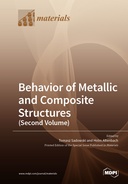Explore

Behavior of Metallic and Composite Structures (Second Volume)
0 Ungluers have
Faved this Work
Login to Fave
Various types of metallic and composite structures are used in modern engineering practice. For aerospace, car industry, and civil engineering applications, the most important are thin-walled structures made of di erent types of metallic alloys, brous composites, laminates, and multifunctional materials with a more complicated geometry of reinforcement including nanoparticles or nano bres. The current applications in modern engineering require analysis of structures of various properties, shapes, and sizes (e.g., aircraft wings) including structural hybrid joints, subjected to di erent types of loadings, including quasi-static, dynamic, cyclic, thermal, impact, penetration, etc.The advanced metallic and composite structures should satisfy multiple structural functions during operating conditions. Structural functions include mechanical properties such as strength, sti ness, damage resistance, fracture toughness, and damping. Non-structural functions include electrical and thermal conductivities, sensing, actuation, energy harvesting, self-healing capability, electromagnetic shielding, etc.The aim of this SI is to understand the basic principles of damage growth and fracture processes in advanced metallic and composite structures that also include structural joints. Presently, it is widely recognized that important macroscopic properties, such as macroscopic sti ness and strength, are governed by processes that occur at one to several scales below the level of observation. A thorough understanding of how these processes influence the reduction of sti ffness and strength forms the key to the design of improved innovative structural elements and the analysis of existing ones.
This book is included in DOAB.
Why read this book? Have your say.
You must be logged in to comment.
Rights Information
Are you the author or publisher of this work? If so, you can claim it as yours by registering as an Unglue.it rights holder.Downloads
This work has been downloaded 97 times via unglue.it ebook links.
- 97 - pdf (CC BY) at Unglue.it.
Keywords
- 3D-printed sandwich
- Adhesion
- adhesive bond strength
- adhesive joint
- adhesive layer thickness
- age-adjusted effective modulus method
- AlCrN
- arc current
- Artificial Neural Networks
- axial compressive behaviour
- beams
- bending response
- bolt
- boundary strengthening
- boundary structure
- C-section
- ceramic-matrix composites (CMCs)
- characterization techniques
- cohesive law
- components of transverse forces in bending
- composite stanchion
- compression
- concrete creep
- concrete filled steel tube (CFST) columns
- confined concrete
- connection
- crashworthiness
- curved steel–concrete composite box beam
- damage
- deformation diagrams
- deformation twin-boundary interaction
- digital image correlation
- dislocation–boundary interaction
- dislocation–interface interaction
- distortional mode
- dual adhesive
- dynamic pulse buckling
- ember-resistant alloys
- energy absorption
- experiment
- failure
- FE analysis
- FEM
- Fracture
- Fracture mechanics
- geometrical optimization
- glued laminated timber
- hardness
- height factor
- I-shaped beam
- interactive buckling
- knots
- Koiter’s theory
- Kolsky method
- laboratory tests
- local compression
- long-term behavior
- material tests
- mechanism maps
- medium length
- membrane components of transverse forces
- minicomposite
- mixed mode I+II loading
- modulus of elasticity
- moisture content
- natural composite
- nonlinear analysis
- nonlinear stability
- numerical modeling
- pine wood
- prediction
- reinforced concrete (RC)
- sandwich panels with corrugated channel core
- shear forces
- single lap joints
- size effect
- square plate
- steel mesh
- steel plate
- steel–concrete composite bridge
- Structure
- Technology, engineering, agriculture
- Technology: general issues
- temperature
- tensile
- test
- TH-section
- through-beam joint
- timber
- turbine jet engine
- two-node finite beam element with 26 DOFs
- Verification
- wear
- Wood
- wood defects
- wood model
- wood species
Links
DOI: 10.3390/books978-3-0365-1491-8Editions

